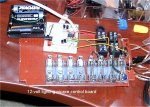Since getting into my picaxe project and playing with LEDs I've really started to take a liking to all this electronics stuff 
I've decided to do a home LED project using CREE XR-E LEDs.. I acquired some warm white (3200-3500k) with a 80lumen/watt efficacy, best you can get on the market at the moment for warm white.
I'm replacing 6 50watt MR16 halogen lights with 9watt LED units (3 LEDs each) running off LM3404 based switching current regs that the national website's web bench tool makes it very easy to design..
I want to figure out the best (cost effective/efficient) way to give this LM3404 HV model a DC voltage supply, minimum 36v, but up to 75v is fine.. if it were regulated to 36-40VCD I could use a lower Vf diode and get 97% total efficiency from the LED driver.. if I go up to 75v I have to use a higher voltage capable diode and I go down to 95%.. not a big hit for a better solution that wasn't so regulated... I only need a 1amp supply. (700mA draw)
I know this doesn't really have anything to do with a picaxe.. hence the topic title.. though I could use one to control/PMW dim and such throughout the day.. I'm looking for a general electronics forum as helpful as this one has been... I thought I'd just blab on about my project for anyone interested..
Where should I sign up to start a discussion about how best to go about this?
I've decided to do a home LED project using CREE XR-E LEDs.. I acquired some warm white (3200-3500k) with a 80lumen/watt efficacy, best you can get on the market at the moment for warm white.
I'm replacing 6 50watt MR16 halogen lights with 9watt LED units (3 LEDs each) running off LM3404 based switching current regs that the national website's web bench tool makes it very easy to design..
I want to figure out the best (cost effective/efficient) way to give this LM3404 HV model a DC voltage supply, minimum 36v, but up to 75v is fine.. if it were regulated to 36-40VCD I could use a lower Vf diode and get 97% total efficiency from the LED driver.. if I go up to 75v I have to use a higher voltage capable diode and I go down to 95%.. not a big hit for a better solution that wasn't so regulated... I only need a 1amp supply. (700mA draw)
I know this doesn't really have anything to do with a picaxe.. hence the topic title.. though I could use one to control/PMW dim and such throughout the day.. I'm looking for a general electronics forum as helpful as this one has been... I thought I'd just blab on about my project for anyone interested..
Where should I sign up to start a discussion about how best to go about this?
Last edited:







